This month we are getting a Lab puppy!
I wanted to write about how I will prepare my adult dog Remy, a 5-year-old weimaraner, for the new arrival in advance.
I think Remy is going to love having a puppy around! He loves other dogs and playing with them. He was absolutely thrilled when we had another weim stay with us for a week last winter.
Introducing a new puppy to your adult dog
When we got Remy as a puppy back in 2016 I assumed my older Lab mix Ace would be fine with a puppy.
He was not!
Ace had met hundreds of dogs and got along beautifully with all of them with top notch doggy social skills.
However, he wanted nothing to do with our new puppy and he would snarl and lunge if Remy got close. This was pretty stressful for me to manage.
With the 10-year age difference between Ace and Remy, I wasn’t concerned with my two dogs becoming best friends. I just wanted them to co-exist peacefully. They could live their separate lives. They just needed to get along.
Turns out, they ended up getting along just fine after about a year – once the puppy matured a bit. They would sleep together for hours a day cuddled up on the same dog bed. Ace died when Remy was 2 years old.
Now that Remy is 5, I hope he and the new puppy can be good friends and playmates. Unlike Ace, who had no interest in playing or wrestling with other dogs even in his younger years, Remy LOVES this kind of full-contact interaction!
How to introduce your dog to a puppy
Below are my tips to help introduce your dog to a new puppy:
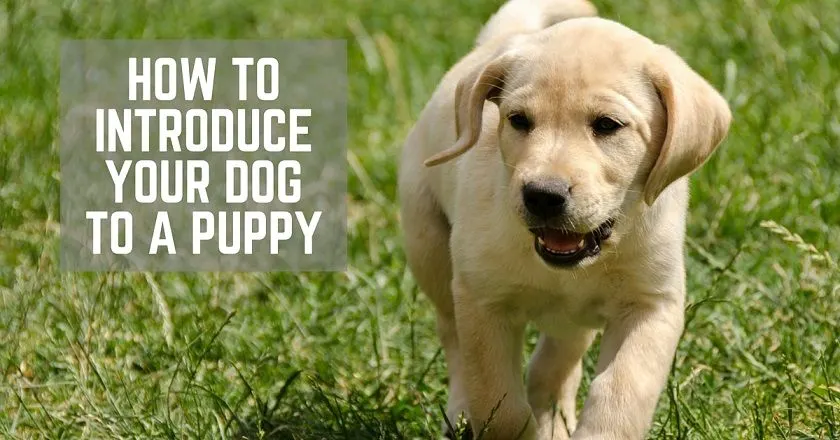
This post was originally published in 2016 when we got Remy and I updated it since we are getting a puppy this year.
1. Introduce your dog and puppy in a neutral area.
It’s usually best to introduce two new dogs in a neutral area such as a park or at the very least, out in the front yard vs. the entryway of your house.
If you’re in a more neutral area, there’s less likelihood for the adult dog to feel possessive or protective. With such a young puppy, this is less of a concern. The adult dog will naturally know the pup is just a baby.
Do your best to keep things fun and positive for your older dog! Praise him for being friendly and gentle or having loose body language.
You do want to avoid areas heavily trafficked with dogs such as dog parks for now because your puppy won’t have all her shots yet. Plus, obviously you don’t want a bunch of random dogs and their owners barging up and interfering.
2. How to do the actual introduction.
Think about what might be best for your own dog. Usually, it’s best to avoid having two dogs meet head on.
In our case, I’ll be flying out of state to pick up my 8-week-old puppy. Once I get home with the puppy, I’ll probably have my husband help me introduce the two dogs out in our front yard.
I might let Remy sniff a towel or something first that the puppy was sitting on in the car.
This will most definitely make Remy extremely excited, though! But I’m pretty sure he’s going to be! His energy might be a bit overwhelming to the puppy. I guess we’ll see!
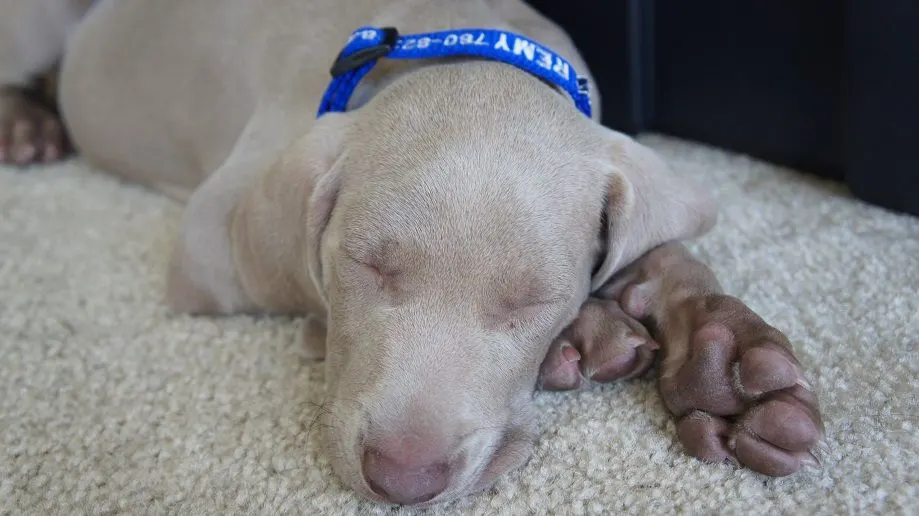
When we introduce them, I will have Remy on a leash while someone else holds the puppy. We’ll probably let him sniff the puppy’s butt first vs. having them meet face to face.
I expect things to go just fine, but we’ll keep Remy on his leash just in case. We’ll probably walk around the yard together for 5 minutes or so.
I’ll praise Remy for any loose body posture like wiggling and tail wagging and curious sniffing. I’ll try to keep things light myself vs. causing any tension.
Then I’ll probably take the puppy inside and hang out with both dogs for a half-hour or so. Then I’ll probably crate them separately for a nap. Maybe that’s optimistic. We’ll see!
What to do if your adult dog shows aggression to the puppy
Hopefully things will go OK during the initial greeting, but if your adult dog is extra tense, growling or otherwise uncomfortable with the puppy (as Ace was), don’t worry. Just take things slow. Don’t force interactions.
Using gates and crates and leashes help a lot!
You may want to read: My dog is aggressive to my puppy
Also: Dogs fighting in the same home
If you’re having issues, it’s always helpful to hire a trainer to come observe and offer suggestions.
3. Puppy proof & set up a week or 2 in advance.
Most dogs are very observant and sensitive to change. You’re probably bringing in all kinds of new supplies for the puppy like gates, toys, a kennel, puppy food, chews, puppy bed, etc.
I recommend you set these things up a week or two before you bring the puppy home so your dog can get used to these minor changes in his environment.
Keep the door to the puppy’s kennel/crate closed so your dog doesn’t make himself at home in that spot and then feel possessive when the pup takes it over later.
For crates, I recommend a wire foldup crate because it’s easy for traveling.
4. Change your routine ahead of time.
Dogs are also sensitive to routine, and obviously your dog’s routine will be disrupted at least a little when the puppy arrives.
We can’t predict everything, but try to think ahead and start making some of these adjustments before you get your puppy.
For example, when I got Remy, Ace was used to being fed and walked as soon as I woke up. But when we got puppy Remy, I would take the puppy outside immediately and walk Ace second.
To plan for this, I adjusted Ace’s schedule before we got the puppy so he was already used to the new routine.
5. Kennel train your puppy.
I know kennel training is not for everyone but man I don’t think I could put up with a puppy if I didn’t have a crate! I plan to start kennel training immediately.
Heck, I think I’ll ask the breeder to start introducing my puppy to a kennel if she’s willing to do that before I even meet my puppy!
With our new pup, I plan to have a crate upstairs in the living room and a second crate downstairs in my office so we always have a safe place to confine the puppy or to separate the two dogs when they’re getting too rowdy.
Remy is crate trained too.
6. Make sure the older dog can get away from the puppy.
Always make sure your dog has a quiet place he can retreat to as he wants. Even if your adult dog is really tolerant of puppy biting and jumping, she shouldn’t have to put up with this all day long!
And if you have a cat, he should also have easy ways to get away too. Baby gates helped us a lot with this.
Make sure you still set aside one-on-one time for your adult dog, like walks, play and training without the puppy.
Other tips for introducing your dog to your puppy:
7. Don’t force interactions between your dog and puppy.
Some dogs become good friends, others remain indifferent.
You can try to encourage them to play, and you can take them on walks together or car rides. Plus, I’m sure you’ll all hang out together in the evenings watching TV or whatever.
I am lucky to work from home, and when we got our puppy Remy, it worked well to have both dogs in my office with me – one loose and one in a crate. That way they got to be around each other but with no pressure to interact.
Let the dogs interact at their own comfort levels. Always separate them when you’re not home.
8. Give them time away from each other.
When we get our Lab puppy, I will do a lot of walks with both dogs together to save time. But, I also want the puppy to learn to be OK left home alone.
I think this is a mistake some people make – they have the puppy with the older dog all the time and then the puppy yowls and cries when separated from the other dog.
To prevent this, I will leave the puppy alone right away from Day 1. It might only be for 10 or 20 minutes, but the puppy needs to learn that sometimes I take my adult dog for a run without him. Or sometimes we all leave to run errands or whatever it may be.
Remy is fine when I leave him alone – no separation anxiety. Probably because he was left a lot right from the start. I would crate him and take my senior dog Ace out for slow walks.
9. Watch for resource guarding
Watch for potential possessiveness of anything such as food & water bowls, toys & bones, dog beds & crates, family members, other pets, furniture – could be anything!
My dog Ace showed terrible resource guarding issues when we got our puppy Remy. Ace would let out a ferocious snarl and lunge if Remy went near a toy or a bowl or even … me, sadly.
He even bit Remy on the head one time, which of course was my fault for putting them in this situation.
So I really want to prevent this from happening again!
See my post: My dog is aggressive to my puppy
Thankfully, Remy is more of a “snatch and grab” kind of resource guarder. Meaning, he will take the item and move away with it. He does not want to start a fight.
But, this is still aggression because he growls and raises his hackles when he does this. I’m working with him on this daily but I see it will be a lifelong issue for Remy.
So, I’ll need to manage their interactions closely around toys, bowls and dog beds. We should all be doing this anyway with new dogs, even if they’ve never shown issues with guarding anything.
I like to feed dogs in separate areas (such as their crates) anyway for less chaos. Certain toys will need to be enjoyed separately, same with rawhides, chews, etc.
I’m not sure if Remy will guard his dog bed. He’s never guarded it from us or our cat but you never know.
10. Puppies need to learn boundaries.
Now, I also want to say that it IS totally normal for an adult dog to set boundaries with a puppy, within reason.
So you don’t want to correct your older dog for growling/barking at the pup when the puppy is being out of line. I know it’s hard to tell sometimes what is appropriate and what isn’t. A trainer can help you if you need advice.
Example of appropriate growling: The older dog is relaxing calmly on his bed. The puppy runs over and starts biting at his ears and climbing on his back. The older dog stiffens, then growls.
In the above scenario, try to re-direct the puppy before he starts to bite and annoy your older dog by calling to him or offering a toy. He needs to learn boundaries and self-control. Help your older dog understand that you have his back.
Example of inappropriate growling, in my opinion: The older dog is relaxing on the floor with a person kneeling next to him. The puppy walks across the room, crossing in front of the older dog with plenty of space and focused on heading elsewhere. The older dog lunges and snarls at the puppy.
In this case, I would say something like, “Oh no” or “What was that?” to show disapproval and then move towards the older dog to back him away or turn my back to him.
Then I would know I need to take it back a step and give my older dog more space away from the puppy while I work on desensitizing him to having the puppy around his resources.
Keep in mind, sometimes all you need is time. There is an adjustment period. Which brings me to …
11. Do your best to get into a routine.
I am obsessed with routine, so we’ll be getting everyone on a schedule the best we can as quickly as we can.
Breakfast at this time, a walk at this time, resting at this time while I work, another walk at this time, etc. I’m very lucky I work from home and can set my own schedule.
I realize this may all go out the window, but here is the schedule I predict as of now.
Example schedule for new puppy:
- 5:30am: Rise and shine, feed the dogs in crates, quick potty break.
- 6: Walk each dog separately or together
- 8-10: Dogs downtime while I work from home (crate as needed).
- 10: Puppy potty break.
- 10:15 to 11:30: Dogs downtime while I work (crate as needed)
- 11:30: Dogs potty break, lunchtime for me
- 12:30: Walk or playtime
- 1:30-3: Dog downtime while I work (crate as needed)
- 3: puppy potty break
- 4:30: Potty break & feed dogs
- 4:30 to 10:30: Hang out all evening, potty breaks as needed
- 10:30: Final potty break & puppy crated for the night
Remy was able to hold it from about 10:30pm to 6:00am as an 8-week-old puppy so I’m hoping our lab puppy will be able to as well! Some puppies need a potty break in the middle of the night.
12. How will you deal with constant roughhousing and playing?
I really do not want the dogs playing constantly in the house, so I’m going to have to be strategic with rules. Do you think it’s possible to train them only to roughhouse outside or in the garage? Sounds like a challenge.
We don’t have a fenced yard. We do have a large, heated garage with horse mats down that they can run around on and wrestle.
The crates and gates will be important for separating them. Remy knows “go to your bed” and “stay” really well, so that will be important to teach the puppy as soon as possible.
I don’t mind a little gentle “silent wrestling” in the house but the constant full-on roughhousing – no.
13. Consider doggie daycare.
Our dog daycare offers a “puppy playroom” program specifically for puppies to play with other puppies. They work on training a bit with them and introducing them to new things. They also have “nap times.” I plan to take advantage of this at least one day a week!
A trainer we’ve worked with has a training space right next door to the daycare and she will go pick up the puppy and train him for 30 mins by appointment. I will have to take advantage of that too!
I’m not sure if I’ll also bring Remy to the daycare (to play with the other adult dogs) or if he’d prefer a day at home without the puppy. We’ll see.
See my post: Is dog daycare a good idea?
So those are my tips!
Let me know, what would you add to the list?
Let me know in the comments!
Additional resources:
- How to introduce two dogs slowly
- Will my dog be sad if I get a puppy?
- 10 tips for preparing for a foster dog
- Puppy potty training
- How far can I walk my puppy?


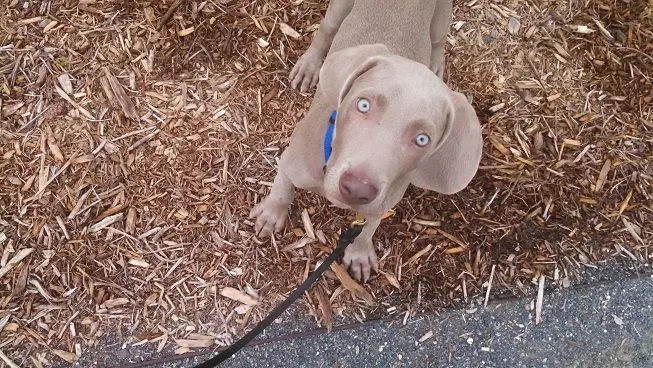
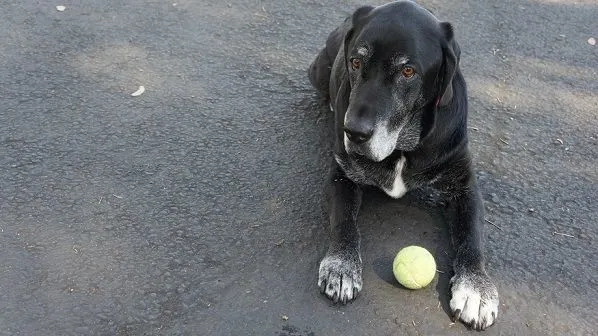
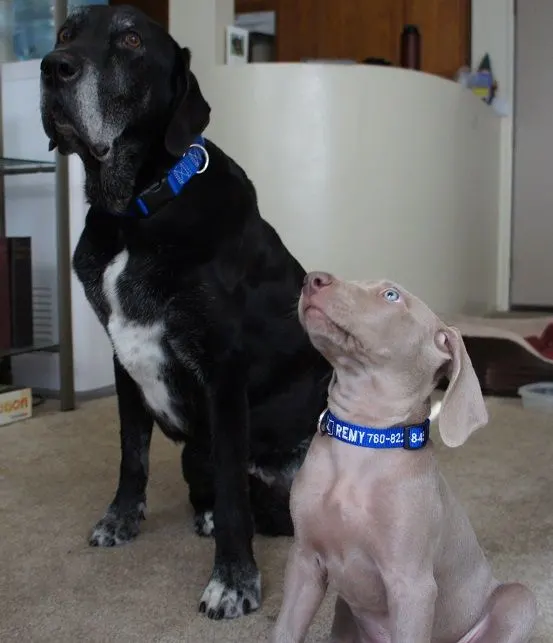
Elaine
Sunday 20th of March 2016
Great tips! I really like your idea of changing your routine ahead of time. I wouldn't have thought about that but you're right, our pups are so used to our routines and they would probably find the changes a little stressful.
It's getting close now, I bet you guys are getting so excited to bring your puppy home soon!
Sandy Weinstein
Thursday 17th of March 2016
hope you enjoy your new puppy. there is a big group of weinars at the local pet events that i go to, usually there are abt 5-6 dogs.
Carol Brandt
Thursday 17th of March 2016
Good article- insightful. I was hoping the pup would be coming from a rescue, however, till I saw you mention a breeder. Good luck with the pup.
Julia at Home on 129 Acres
Wednesday 16th of March 2016
It's great that you're putting so much thought into this. Thanks for sharing your tips.
Colby
Wednesday 16th of March 2016
Here's how our dogs handled introduction to our 8 week old puppy, Archer:
Stetson: Indifferent Linus: Bossy Raven: Playful
Raven and Archer are best friends, but at 1.5 years old she's still a puppy too. Stetson is indifferent and jumps up on the bed/couch to get away from Archer. He hasn't played with one of our puppies since Derby (8 years ago). Linus is the boss of the house and tells everyone (including the pups) when they are getting to rambunctious. Linus can be possessive with his food so I always have to keep an eye on new puppies when it's meal time.
As you said: "Know your dog" That's probably the most important thing and you know Ace and can pretty well predict what his behavior and reactions will be.